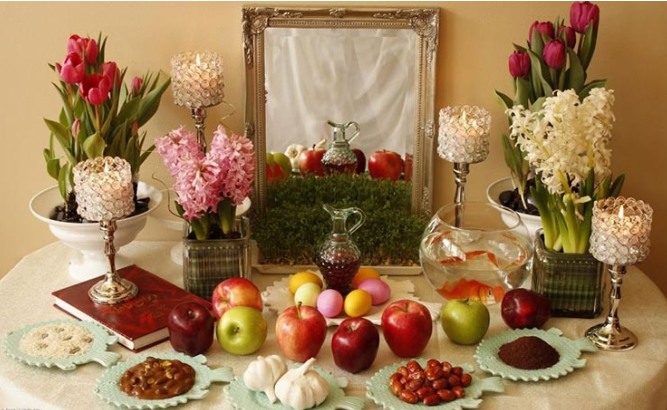Nowruz marks the first day of spring, or Equinox, and the beginning of the year in the Persian calendar. It is celebrated on the day of the astronomical northward equinox, which usually occurs on March 21 or the previous or following day, depending on where it is observed. The moment the sun crosses the celestial equator and equalizes night and day is calculated exactly every year, and families gather together to observe the rituals.
Nowruz has been celebrated by people from diverse ethnic communities and religious backgrounds for thousands of years. It is a secular holiday that is enjoyed by people of several different faiths. It originated in Persia in one of the capitals of the Achaemenid empire in Persis (Fars) in Iran and is also celebrated by cultural regions that came under Iranian influence or which had migrations by Persians including Azerbaijan, the North Caucasus, Kurdish inhabited regions of eastern Turkey and Northern Iraq, Afghanistan, Pakistan, Tajikistan, Turkmenistan, Uzbekistan, Kyrgyzstan, Kazakhstan, and other scattered populations in Central and South Asia.
The term Nowruz first appeared in writing in historical Persian records in the 2nd century CE, but it was also an important day during the time of the Achaemenids (c. 550–330 BCE), where kings from different nations under the Persian Empire would bring gifts to the Emperor, also called the King of Kings (Shahanshah) of Persia, on Nowruz. The significance of Nowruz in the Achaemenid Empire was such that the great Persian king Cambyses II’s appointment as the king of Babylon was legitimized only after his participation in the New Year festival.
The UN’s General Assembly has recognized the International Day of Nowruz, describing it as a spring festival of Persian origin which has been celebrated for over 3,000 years. During the meeting of the Intergovernmental Committee for the Safeguarding of the Intangible Cultural Heritage of the United Nations, held 2009, Nowruz was registered on the UNESCO Representative List of the Intangible Cultural Heritage of Humanity.
Haft-Seen, also spelled as Haft Sīn (Persian: هفتسین, the seven seen’s), is a tabletop (sofreh) arrangement of seven symbolic items traditionally displayed at Nowruz. The haft-seen table includes seven items all starting with the letter Seen (letter s, fa, س) in the Persian alphabet.
The Haft-Seen table items include:
- Sabzeh (سبزه) – wheat, barley, mung bean, or lentil sprouts growing in a dish, symbolizing rebirth
- Samanu (سمنو) – sweet pudding made from wheat germ, symbolizing affluence
- Senjed (سنجد) – dried oleaster, a wild olive fruit, symbolizing love
- Seer (سیر) – garlic, symbolizing medicine and health
- Seeb (سیب) – apple, symbolizing beauty
- Somāq (سماق) – sumac fruit, symbolizing the color of the sunrise
- Serkeh (سرکه) – vinegar, symbolizing old age and patience
The following items may also appear on the Haft-Seen table as ornaments or for the sake of completeness. Although some of these items are Persian symbols, they are not a main part of the traditional Haft-Seen.
- A holy book
- Divan-e Hafez, a Persian poetry book
- a mirror
- a goldfish in a bowl, symbolizing life
- a brazier of fire
- a lamp
- cypress or pine
- pomegranates
- painted eggs
- coins, symbolizing wealth
- candles
- a bowl of water
- wheat or bread
















